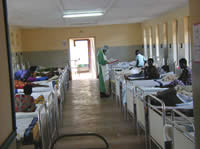|
|
 |
| Priority
Area 1: International Outbreak Assistance |
 |
|
Outbreak
of Ebola hemorrhagic fever, Uganda, 2000. The isolation
ward of Gulu Municipal Hospital, Gulu, Uganda, during
an outbreak of Ebola hemorrhagic fever in October 2000.
There is no known drug treatment or vaccine for this
disease, which is transmitted person-to-person through
contact with infected bodily fluids and has a case-fatality
ratio of 50–90%.
At
the invitation of the Ugandan Ministry of Health, CDC
sent several teams of scientists to Gulu to participate
in a multinational WHO-coordinated response team. The
response team helped bring the epidemic under control
by providing assistance and consultation to help rapidly
identify cases, provide safe care, and interrupt the
spread of the virus.
Photographer:
Daniel Bausch, Division of Viral and Rickettsial Diseases,
National Center for Infectious Diseases, CDC |
|
|
When a new, highly dangerous, or reemerging disease is detected anywhere
on the globe—whether in a developing or industrialized country, in
a close ally or a “nation of concern”—U.S. citizens, as
well as foreign governments, often rely on CDC to provide outbreak assistance
and public health information. CDC is unusual among public health institutions
in its comprehensive capacity to identify a wide range of infectious bacteria,
viruses, fungi, parasites, and rickettsia.
In past years, however, maintaining this capacity has not always been
a priority. Attempts have been made to cut costs by reducing support for
laboratory expertise on diseases that are currently uncommon in the United
States, including zoonotic diseases like plague and leptospirosis. However,
CDC’s repeated experience with outbreaks of diseases once thought
to be archaic or obscure—including a 1994 outbreak of plague in India,
a 1995 outbreak of a virulent pulmonary form of leptospirosis in Nicaragua,
and a 2000 outbreak of leptospirosis in Malaysian Borneo among athletes
at an international competition (Box 11)—has underscored the value
of having a comprehensive, integrated ability to identify and investigate
most human diseases and to recognize new threats. However, gaps remain
in CDC’s repertoire of diagnostic tools in such areas as diseases
caused by prions (e.g., new variant Creutzfeldt-Jakob disease, the human
consequence of infection with bovine spongiform encephalopathy, or “mad
cow disease”), and some areas require upgrading to remain effective
(e.g., leptospirosis, yellow fever, diphtheria, anthrax, and helminthic
diseases).
CDC frequently collaborates on international outbreak investigations
conducted in partnership with host nations. CDC participation occurs on
an ad hoc basis, in response to requests for assistance from foreign governments
or WHO. There is no formal structure for this activity, nor are there
designated resources. An underlying principle of the global strategy is
the recognition that international outbreak assistance is an integral
function of CDC. Supporting this function will require augmenting, updating,
and strengthening CDC’s diagnostic facilities, including laboratories
that participate in the WHO Collaborating Centre network, as well as capacity
for epidemiologic investigation overseas, including field logistics and
data management.
Outbreak follow-up. In the future, as part of the global
strategy, CDC will routinely offer to assist host-country ministries of
health and WHO in assessing the public health situation in the aftermath
of a major outbreak. If requested, CDC will send a dedicated prevention
team to revisit the outbreak site and suggest additional strategies to
improve disease surveillance and outbreak response. The team will share
clinical and epidemiologic outbreak data with health authorities and work
to strengthen local laboratories. The team may also sponsor local workshops
or conferences to consider lessons learned from the outbreak, review local
hospital resources, and discuss long-term surveillance efforts. These
follow-up efforts will help maintain mutually beneficial relationships
and research partnerships between CDC, WHO, and local health authorities
(Box 12 and Priority Area 2). Previous
page | Next
page |
 |
 |
 |
|
 |


